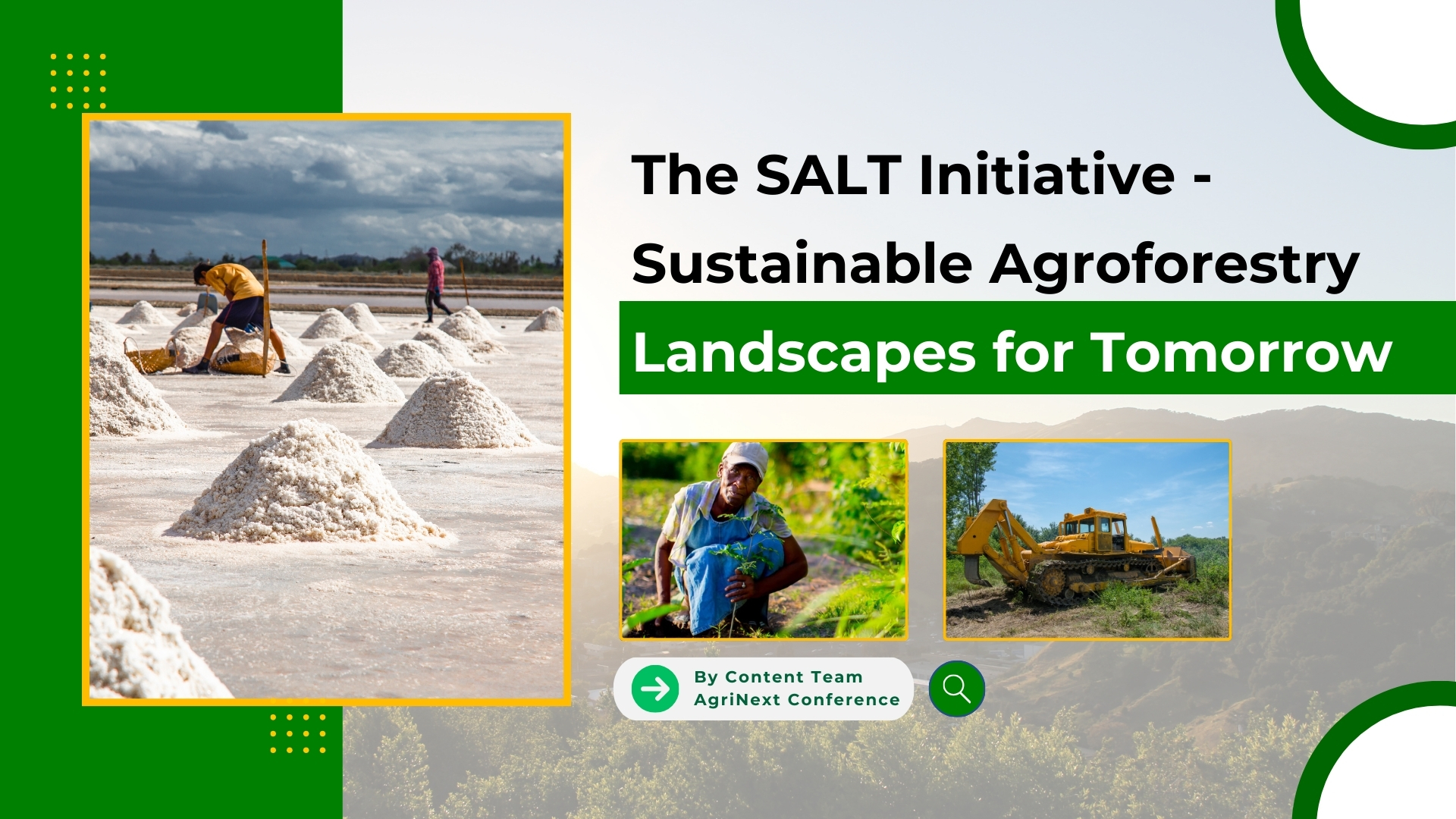
Location: Southeast Asia (Specifically in Indonesia)
Introduction
The SALT Initiative is a collaborative project between local communities, NGOs, and government agencies aimed at promoting sustainable agroforestry practices on sloping agricultural lands in rural landscapes. Recognizing the challenges of soil erosion and land degradation on sloping terrain, the project focuses on revitalizing degraded lands and improving livelihoods through the adoption of agroforestry systems.
Table of Contents

History of SALT:
SALT Technology, an agroforestry scheme developed by the Mindanao Baptist Rural Life Center (MBRLC) in Kinuskusan, Bansalan, Davao del Sur, Philippines.
For Our Other Article, click here
Visit our LinkedIn Page, click here
Sustainable Agroforestry Systems Implemented:
Contour Hedgerow Intercropping (SALT/CHIAT):
Along sloping terrain, dense hedgerows of fast-growing perennial nitrogen-fixing trees or shrub species are strategically planted along contour lines. These nitrogen-fixing trees play multifaceted roles in SALT agroforestry systems, serving as soil binders, generators of natural fertilizers, and sources of livestock feed. Their resilience allows them to thrive in poor soils and endure long dry seasons, making them invaluable for restoring forest cover to denuded watersheds, slopes, and other degraded lands.
Among the nitrogen-fixing plants commonly utilized in SALT agroforestry are Leucaena leucocephala, Leucaena diversifolia, Gliricidia sepium, Albizia lebbeck, and Calliandra calothyrsus. These species are carefully selected for their ability to thrive in the specific environmental conditions of sloping agricultural land, while also providing a range of ecosystem services.
In addition to controlling soil erosion by reducing water runoff and enhancing soil moisture retention, these living barriers contribute to nutrient cycling, habitat creation for beneficial insects and wildlife, and overall ecosystem resilience. By integrating these nitrogen-fixing trees into SALT agroforestry systems, farmers can effectively improve soil fertility, mitigate erosion, and promote sustainable agroforestry land management practices.”
Agroforestry Buffer Strips:
In areas prone to soil erosion, agroforestry buffer strips are established along watercourses and field boundaries on sloping agricultural land. These buffer strips consist of trees, shrubs, and perennial grasses planted in bands or strips to slow down water runoff, trap sediment, and filter pollutants, thereby protecting downstream water quality and reducing soil erosion.
Terrace Farming with Agroforestry:
On steep slopes, terrace farming combined with agroforestry is employed to create flat or gently sloping terraced fields. Trees, shrubs, and cover crops are planted on terrace edges and retaining walls or embankments to preserve the soil, reduce erosion, and improve soil fertility. Terrace farming with agroforestry enhances agricultural productivity while minimizing soil loss and water runoff on sloping terrain. Terrace farming is particularly well-suited to regions with steep or mountainous terrain where flat land is limited.
Outcomes and Impacts:
Environmental Benefits:
Agroforestry practices implemented as part of the SALT Initiative offer a range of environmental benefits, contributing to the restoration and preservation of ecosystems on sloping agricultural land. Some of these benefits include:
Soil Conservation:
The integration of trees and shrubs in agroforestry systems helps prevent soil erosion on sloping terrain. Tree roots stabilize the soil structure, reducing the risk of landslides and soil degradation caused by water runoff.
Carbon Sequestration:
Trees play a vital role in capturing and storing carbon dioxide from the atmosphere through photosynthesis. Agroforestry practices promote carbon sequestration in soil organic matter and biomass, mitigating climate change and enhancing ecosystem resilience.
Biodiversity Enhancement:
Agroforestry systems create diverse habitats that support a wide range of plant and animal species. Agroforestry practices facilitate the restoration of degraded landscapes by reintroducing native tree species and restoring natural vegetation cover. This helps rehabilitate degraded ecosystems, promote soil fertility, and create resilient habitats for native flora and fauna.
Water Management:
Trees and vegetation in agroforestry systems help regulate water flow, reduce surface runoff, and improve water infiltration into the soil. This contributes to enhanced water retention, groundwater recharge, and improved water quality in rivers and streams.
Economic Opportunities:
In addition to the environmental benefits, the SALT Initiative presents various economic opportunities for rural communities living in sloping agricultural landscapes. These opportunities include:
Diversified Income Sources:
Agroforestry systems diversify income sources for farmers by incorporating multiple products and services. Farmers can generate revenue from timber production, fruit and nut harvesting, non-timber forest products, and ecotourism activities, reducing dependency on a single crop or livelihood activity.
Value-Added Products:
Agroforestry products such as fruits, nuts, medicinal plants, and handicrafts contribute to local economies. Farmers can process and market value-added products, such as jams, jellies, essential oils, and artisanal crafts, generating higher returns and capturing more value along the supply chain.
Employment Opportunities:
Agroforestry projects create employment opportunities for rural communities in various stages of implementation, including tree planting, maintenance, harvesting, and processing.
Market Access:
Agroforestry products from the SALT Initiative can access targeted markets, specialty stores, and eco-friendly consumers who value sustainably sourced and locally produced goods. Farmers can capitalize on market demand for organic, fair-trade, and environmentally friendly products, commanding premium prices and enhancing profitability.
Capacity Building and Training:
The SALT Initiative provides opportunities for training, and skill development among local communities. Farmers learn new techniques, agroforestry practices, and sustainable agroforestry land management strategies, improving their agricultural productivity, income potential, and resilience to environmental challenges.
Challenges and Lessons Learned:
Implementing sustainable agroforestry practices as part of the SALT Initiative comes with its own set of challenges and valuable lessons that have been learned along the way.
Key of Challenges and Lessons
Some of the key challenges and lessons include:
Land Tenure and Ownership:
Securing land tenure and ownership rights for agroforestry projects can be challenging, particularly in areas with complex land tenure systems or competing land uses. Clearing land tenure issues and establishing secure land tenure arrangements are essential for long-term investment and sustainability of agroforestry initiatives.
Technical Knowledge and Capacity:
Building technical knowledge and capacity among farmers and local communities is crucial for the successful implementation of agroforestry practices.
Financial Resources and Investment:
Access to financial resources and investment capital is essential for scaling up agroforestry projects and sustaining long-term operations. Securing funding from government grants, donor agencies, private investors, and development banks can be challenging, requiring innovative financing mechanisms and partnerships to mobilize resources effectively.
Market Access and Value Chains:
Developing market access and value chains for agroforestry products is critical for ensuring economic viability and profitability for farmers.
Community Engagement:
Encouraging active participation and involvement from all community members can be challenging, as some individuals may be reluctant or unable to participate due to time constraints, lack of interest, or competing priorities.
Overcoming communication barriers, such as language differences, cultural norms, and literacy levels, can hinder effective engagement and collaboration with diverse community members, making it challenging to convey information and solicit feedback
Lessons Learned:
Integrated Approach:
Taking an integrated approach that combines technical, social, economic, and environmental aspects is key to the success of agroforestry initiatives. Integrating multiple objectives, stakeholders, and perspectives helps address complex challenges and maximize synergies between agriculture, forestry, and conservation goals.
Adaptive Management:
Embracing adaptive management approaches that allow for flexibility, learning, and continuous improvement is essential for navigating uncertainties and changing conditions. Monitoring, evaluation, and adaptive management enable project teams to respond to feedback, adjust strategies, and optimize outcomes over time.
Knowledge Sharing and Collaborations:
Bringing together different people to share knowledge, work together, and form partnerships enhances learning, innovation, and capacity building.
Long-Term Vision and Commitment:
Maintaining a long-term vision and commitment to sustainability is critical for overcoming short-term challenges and achieving lasting impact.
Conclusion:
The SALT Initiative exemplifies the transformative potential of sustainable agroforestry practices in addressing soil erosion and land degradation on sloping agricultural land. Through the implementation of agroforestry systems such as Contour Hedgerow Intercropping (SALT/CHIAT), agroforestry buffer strips, and terrace farming with agroforestry, the SALT Initiative demonstrates the transformative potential of sustainable land management practices.
As we move forward, it is essential to continue supporting initiatives like the SALT Initiative that prioritize sustainable agroforestry as a key strategy for promoting environmental conservation, economic development, and social equity. By investing in long-term vision, community participation, and institutional support, we can unlock the full potential of sustainable agroforestry to build resilient landscapes, enhance livelihoods, and secure a sustainable future for generations to come.
Signup For AgriNext Conference Newsletter

